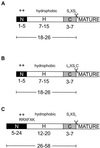Protein targeting to the bacterial cytoplasmic membrane
- PMID: 10066835
- PMCID: PMC98961
- DOI: 10.1128/MMBR.63.1.161-173.1999
Protein targeting to the bacterial cytoplasmic membrane
Abstract
Proteins that perform their activity within the cytoplasmic membrane or outside this cell boundary must be targeted to the translocation site prior to their insertion and/or translocation. In bacteria, several targeting routes are known; the SecB- and the signal recognition particle-dependent pathways are the best characterized. Recently, evidence for the existence of a third major route, the twin-Arg pathway, was gathered. Proteins that use either one of these three different pathways possess special features that enable their specific interaction with the components of the targeting routes. Such targeting information is often contained in an N-terminal extension, the signal sequence, but can also be found within the mature domain of the targeted protein. Once the nascent chain starts to emerge from the ribosome, competition for the protein between different targeting factors begins. After recognition and binding, the targeting factor delivers the protein to the translocation sites at the cytoplasmic membrane. Only by means of a specific interaction between the targeting component and its receptor is the cargo released for further processing and translocation. This mechanism ensures the high-fidelity targeting of premembrane and membrane proteins to the translocation site.
Figures



References
-
- Akita M, Sasaki S, Matsuyama S, Mizushima S. SecA interacts with secretory proteins by recognizing the positive charge at the amino terminus of the signal peptide in Escherichia coli. J Biol Chem. 1990;265:8164–8169. - PubMed
-
- Altman E, Bankaitis V A, Emr S D. Characterization of a region in mature LamB protein that interacts with a component of the export machinery of Escherichia coli. J Biol Chem. 1990;265:18148–18153. - PubMed
-
- Altman E, Emr S D, Kumamoto C A. The presence of both the signal sequence and a region of mature LamB protein is required for the interaction of LamB with the export factor SecB. J Biol Chem. 1990;265:18154–18160. - PubMed
Publication types
MeSH terms
Substances
LinkOut - more resources
Full Text Sources
Other Literature Sources

